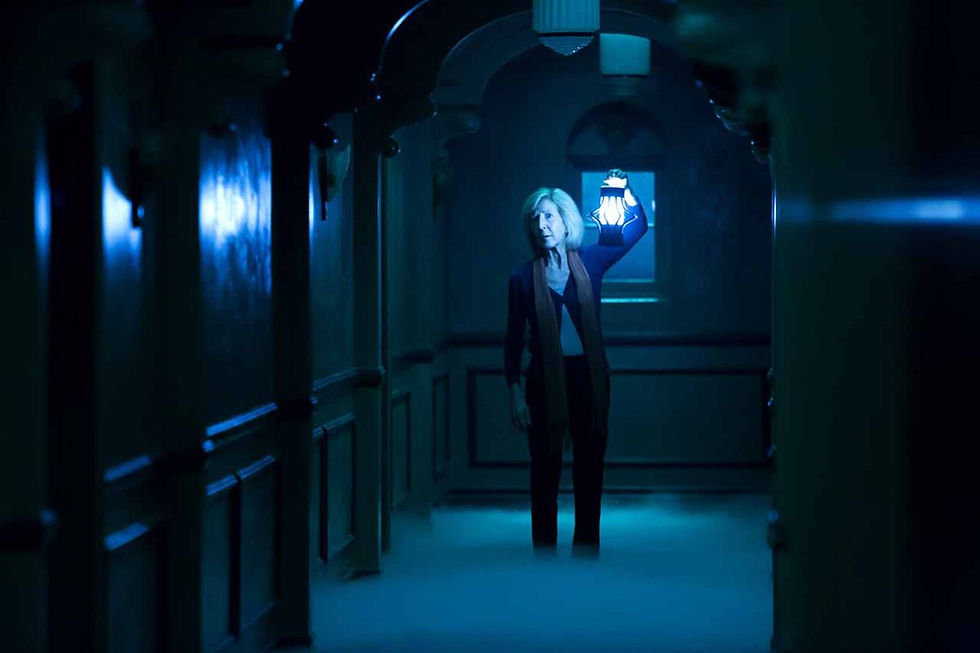Boo! Why You Hate Jump Scares
- Grace Davidson-Lynch

- Aug 24, 2020
- 7 min read
Updated: Aug 25, 2020
Minor spoilers for Insidious and When A Stranger Calls...
For my fifteenth birthday, my parents took me to see The Mousetrap at Sydney Theatre Company. As a young woman with a burgeoning passion for the theatre, and an avid Agatha Christie reader, I had a wonderful time.
It was decidedly not a horror play. But it was also my first theatre jump scare.
I can remember it with alarming clarity. The play takes place at Monkswell Manor, which soon becomes the setting for a series of awful murders. The hotel is snowed in, the telephone line is down, and our guests are trapped with a murderer in their midst. In the drawing room, two characters speak in hushed tones about the danger that lurks all around them.
Suddenly, a gloved hand appears at the door, deftly flicks the light switch, and the auditorium is plunged into darkness. And, as I sat in my seat, my stomach dropped and the air escaped my lungs.

We all know the feeling.
The tingling in your limbs, the sharp intake of air, the shaking in your hands. Fear is a very common emotion, but jumping with fear is perhaps the most powerful of all feelings. It sparks a fight-or-flight reflex. The muscles engage, and specific hormones are released in preparation for escape. These hormones cause reduced digestion activity, creating the sensation of butterflies in your stomach, dilated pupils, increased activity in the heart and lungs, reduced hearing, and tunnel vision. Of course, after this initial hormonal and muscular response, your brain’s hippocampus and prefrontal cortex (which control high-level decision making) are engaged to determine the level of threat and an appropriate response. Plays, films and games will trigger an initial fear response with the understanding that audience's brains will quickly realise that the threat is not actual. This fear response is not limited to horrific things; anyone with a phobia knows that sometimes the human brain will have a fear response to non-threatening entities.
One of the easiest ways to trigger a fear response is by using a jump scare.
Jump scares certainly have their place in horror theatre, but have become synonymous with horror films. And in this arena, jump scares tend to attract audience ire because they are one of those horror techniques that can be immediately recognised. Other potentially tacky techniques- like oblique camera angles or moving light sources - are harder to define as the flashpoint from which terror originates. They also represent something of a breakdown in audience trust. As with any fictional world, a horror movie is at its most believable when it behaves consistently. Loud sounds and flashes of gore are not congruent with reality as we actually experience it, so jump scares are often seen as filmmakers abusing our trust in the language of film to make us panic, if only for a moment.
A bad jump scare can also represent a complete misunderstanding of tension.
All horror dramas- on stage, in a cinema, or on a screen- follow basic rules of tension building and release. Horror is very similar, dramaturgically, to comedy or pornography. These forms are designed to elicit a very specific physical reaction- fear, laughter, sexual gratification, etc. And while these forms may allow some space for intellectual stimulation, this is secondary to the physical response. Horror, and other forms concerned with physical reactions, will often follow a pattern that repeats several times in the course of a narrative…
1. The setup- the rules of engagement are conveyed to an audience
2. The subversion- events in the narrative change the audience’s understanding of the rules
3. The climax- the fissure created by the changing of the rules erupts
4. The explanation- the eruption is responded to in whatever manner is deemed appropriate
An urban legend is a great example of a quick, non-repeating implementation of this structure-
1. The setup- On a peaceful Saturday night, Cindy is babysitting the neighbour's two daughters. She puts the children to bed, then goes downstairs to watch TV.
2. The subversion- Someone calls the home phone, urging Cindy to “go check on the children”. Cindy receives this phone call several more times. After the third call, she phones the police, who tell her they will trace the call next time it comes through.
3. The climax- After the fourth call, the police tell Cindy that the call is coming from inside the house, and she has to leave immediately. Cindy escapes out the front door.
4. The police are waiting outside, and Cindy flees into their arms. When officers check the children, they find they have been brutally murdered. They arrest the killer, who was hiding in the wardrobe, waiting for the babysitter to come and check on the children.
The story is certainly a horrific one, but it is also objectively silly. How did the killer call the babysitter from inside the house without the babysitter hearing it? Why did the children make no sound? Why would the police simply trust the babysitter and trace the call without any apparent threat? But these details don’t trouble the audience, because they fall outside of the scope of logic established by the setup. The focus is on Cindy and the phone with all extraneous details ignored. Because, although the story is violent and upsetting, the events of the story are very simple- this is the case with most horror media.
A story is only scary because it is relayed in a way that is scary.

Cindy’s perspective aligns with the audience, and we experience her narrative and the building of tension firsthand. What if the story was told from the killer’s perspective? All he did was sneak in, murder two children, then hide in a cupboard- there is no room for tension to build because the killer has entirely too much knowledge to feel afraid. Cindy is in the dark about what is haunting her, while the killer is aware that his foe is a 15-year-old girl. What if the story was told from the perspective of the police officer? Here there is room for some tension, but again, as he was probably aware that a child killer was lurking in the upstairs bedroom, he at least has a chance to pull a gun and feel safer than Cindy does.
In a horror narrative, the audience is often aligned with characters who have almost no understanding of the new rules of engagement. A 15-year-old babysitter has a worse chance at surviving an encounter with a killer than a 35-year-old police officer, but the disparity comes in the form of preparedness. The officer had a gun and expectations of finding a killer- Cindy expected to watch TV and go home at midnight.
Most modern horror jump scares are placed at step three- the climax. Maybe the moment of revelation is accompanied by a loud noise, or a musical sting, or a scary image. Cindy hears the police tell her to leave, then turns to see a killer standing on the landing- covered in blood, mask on, as the music spikes in volume. The reason a scare like this feels cheap is because it is an all-or-nothing approach to the climax. It combines music and gore to ‘ruin’ the tension by overdoing it. And, because modern audiences expect to be scared in this way, the confirmation of a jump scare lessens the impact of the tension building that came before it; we see through the facade.
The most effective jump scares are usually placed at step two- the subversion. Cindy sits alone in a dimly-lit suburban living room. Suddenly, the phone rings loudly. She jumps, we jump, and she quickly goes to answer it so as not to wake the girls upstairs. Some of the best film jump scares happen at moments like this. Insidious is a horror film I have issues with, but one particular jump scare has gone down in history as one of cinema’s best.
A well-lit suburban dining room in the middle of the day. A grandmother recounts a terrifying nightmare she had about her grandson. She explains how her understanding of the family’s situation has been subverted by the events that have taken place. The camera focuses on the grandmother, cutting to her son and daughter-in-law occasionally to show the audience their concerned expressions.
And then, a clicking noise filters through the conversation.
Then we (the audience) and Lorraine (the confused grandmother) witness and hear this-

What appears to be a lull in a conversation is, in fact, revealed to be just as tense as a dimly-lit corridor on a stormy night, or shadowy figure that vanishes in a blink.
Rather than fulfilling audience expectations with a quick startle at the height of the terror, a jump scare during this phase of the narrative simply elevates the stakes and broadens the scope of possibility. The audience is never truly safe after this point, because the mundane can be used against them. But, crucially, the mundane is never contrived to be scarier than it actually is- a telephone ringing and a demon in the dining room make complete sense in the horror worlds they are a part of.
Because ultimately, jump scares are a part of our real lives. We jump at loud noises, unexpected noises, shadows on the wall, near misses in the car- just about anywhere where our expectations are violently or loudly distorted. But these events are not accompanied by stinger sound effects or spooky music. Jump scares are at their most effective when they resemble the ways that we jump in our everyday lives.
I would love to end this post on a jump scare, as is the way with modern horror, but that's not feasible in this form. My post is over, the tension is gone, and you may peacefully go about your day again.
Besides, you're expecting it, right?
Maybe later, when a door slams and you are the only one home, you'll think back to this post. And remember, a good jump scare is not the end of the horror.
It's only the beginning.

What do you think? Do you like a good jump scare? Leave your musings in the comments, or on Facebook!
References
Newman, T & Collier, J 2018, 'Dissecting terror: how does fear work?', Medical News Today, 31 Oct, <https://www.medicalnewstoday.com/articles/323492#Why-do-we-freeze-when-were-scared?>.
Images
The Mousetrap still © Sydney Theatre Company
Rotary phone image © Unsplash
Insidious stills © FilmDistrict



Comments